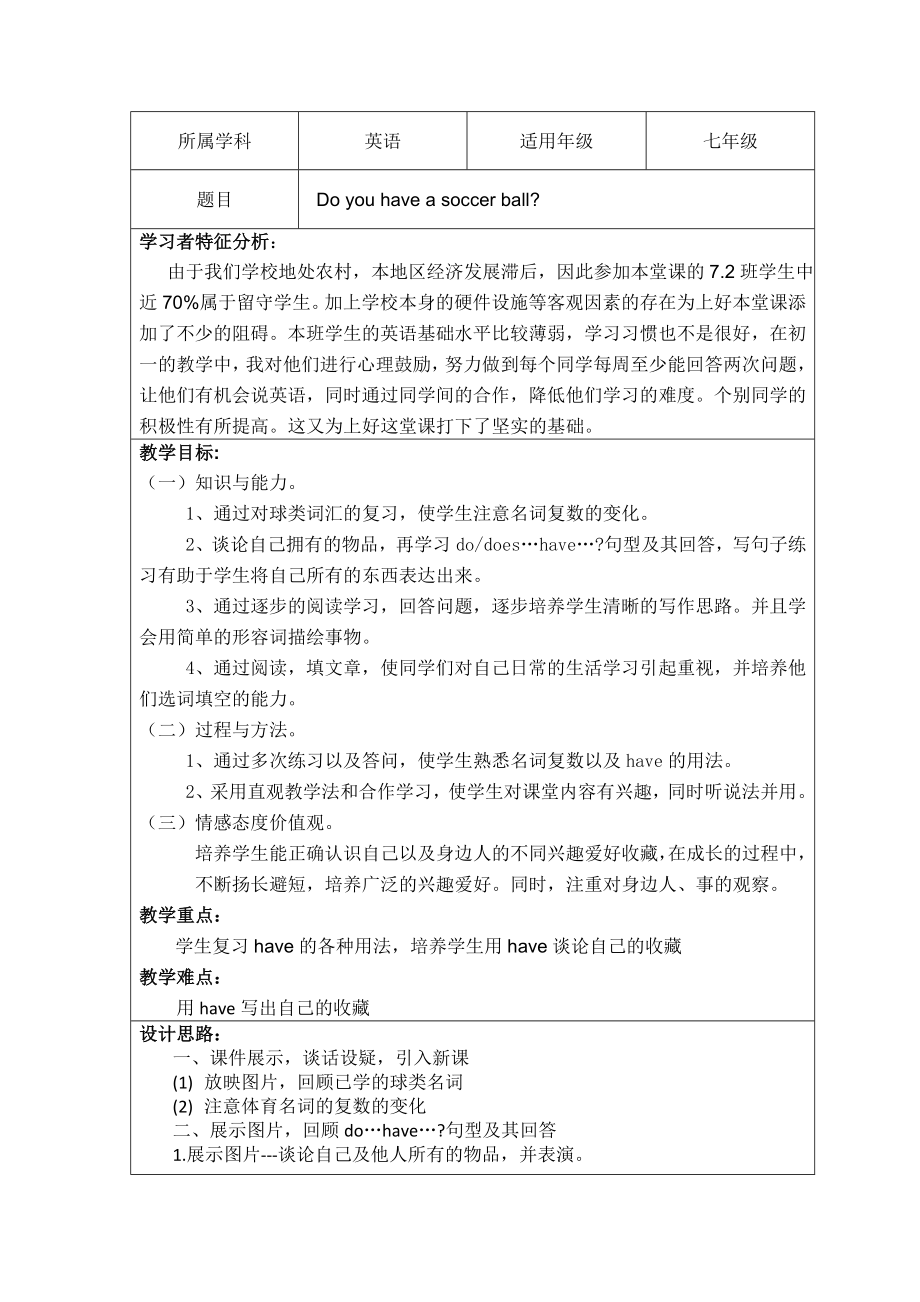《人教版英語七年級上冊Unit 5 What are the shirts made of_ Section B2a-2c表格式教案》由會員分享,可在線閱讀����,更多相關(guān)《人教版英語七年級上冊Unit 5 What are the shirts made of_ Section B2a-2c表格式教案(3頁珍藏版)》請在裝配圖網(wǎng)上搜索。
1��、所屬學(xué)科
英語
適用年級
七年級
題目
Do you have a soccer ball?
學(xué)習(xí)者特征分析:
由于我們學(xué)校地處農(nóng)村��,本地區(qū)經(jīng)濟發(fā)展滯后����,因此參加本堂課的7.2班學(xué)生中近70%屬于留守學(xué)生。加上學(xué)校本身的硬件設(shè)施等客觀因素的存在為上好本堂課添加了不少的阻礙����。本班學(xué)生的英語基礎(chǔ)水平比較薄弱,學(xué)習(xí)習(xí)慣也不是很好���,在初一的教學(xué)中�����,我對他們進行心理鼓勵�����,努力做到每個同學(xué)每周至少能回答兩次問題���,讓他們有機會說英語�,同時通過同學(xué)間的合作�,降低他們學(xué)習(xí)的難度��。個別同學(xué)的積極性有所提高�。這又為上好這堂課打下了堅實的基礎(chǔ)�。
教學(xué)目標(biāo):
(一)知識與能力�����。
1��、通過對球
2���、類詞匯的復(fù)習(xí),使學(xué)生注意名詞復(fù)數(shù)的變化�����。
2、談?wù)撟约簱碛械奈锲?����,再學(xué)習(xí)do/does…h(huán)ave…?句型及其回答�����,寫句子練習(xí)有助于學(xué)生將自己所有的東西表達出來��。
3��、通過逐步的閱讀學(xué)習(xí)����,回答問題,逐步培養(yǎng)學(xué)生清晰的寫作思路��。并且學(xué)會用簡單的形容詞描繪事物�。
4、通過閱讀�����,填文章�,使同學(xué)們對自己日常的生活學(xué)習(xí)引起重視�,并培養(yǎng)他們選詞填空的能力���。
(二)過程與方法����。
1��、通過多次練習(xí)以及答問���,使學(xué)生熟悉名詞復(fù)數(shù)以及have的用法���。
2、采用直觀教學(xué)法和合作學(xué)習(xí)�����,使學(xué)生對課堂內(nèi)容有興趣�,同時聽說法并用。
(三)情感態(tài)度價值觀��。
培養(yǎng)學(xué)生能正確認(rèn)識自己以及身邊人的不同興趣愛好收藏�����,在成
3�����、長的過程中��,不斷揚長避短�,培養(yǎng)廣泛的興趣愛好。同時�����,注重對身邊人�����、事的觀察����。
教學(xué)重點:
學(xué)生復(fù)習(xí)have的各種用法,培養(yǎng)學(xué)生用have談?wù)撟约旱氖詹?
教學(xué)難點:
用have寫出自己的收藏
設(shè)計思路:
一�、課件展示,談話設(shè)疑��,引入新課
(1) 放映圖片�,回顧已學(xué)的球類名詞
(2) 注意體育名詞的復(fù)數(shù)的變化
二����、展示圖片�����,回顧do…h(huán)ave…?句型及其回答
1.展示圖片---談?wù)撟约杭八怂械奈锲?,并表演?
2.完成書上2a部分的內(nèi)容,寫出自己有得沒得體育用品����。并口頭表述出來。在句子中必須要用到have和don’t have��。
三��、圖片展示���,完成閱讀��。
4�����、1.聽錄音���,并勾出文章中得球類詞匯。同時注意文章的語調(diào)���。
2.指出文章中得部分單詞�����,學(xué)習(xí)單詞的用法���。
3.學(xué)生自主快速閱讀,回答 who has a soccer ball?
4.學(xué)生細讀文章���,完成書上2c部分的內(nèi)容���。
5.學(xué)生精讀文章,根據(jù)文章回答問題����。
6.學(xué)生齊讀文章,然后完成練習(xí)題----根據(jù)課文完成練習(xí)�。
四、作業(yè)
通過總結(jié)已學(xué)的內(nèi)容���,要求學(xué)生按要求完成作文��。
教學(xué)過程:
教學(xué)環(huán)節(jié)
教學(xué)內(nèi)容
教師活動
學(xué)生活動
設(shè)計意圖
Warming up
1.Show pictures to guide students to review the balls.
5���、 And pay attention to the plural forms of these nouns.”
Show students some pictures and ask ss to review balls.
Watch pictures and review the balls.
It aims to interest students.
Talking and writing
Talk about what you have and you don’t have by using “do you have…?/does she/he have…?”sentence
6�����、patterns and so on. And then write them down. At the same time, students say out “I have…, I don’t have….
T shows pictures and guide ss to talk about what you have and what you don’t have. At the same time, T guides students to pay attention to “have and don’t have”
Students observe pictures, tal
7�、k about their own ownership. And then show their conversations. Then write down what they have and they don't have. Then say out the sentences.
Students learn to pay attention to have and don't have. It is the basis of following study.
reading
Read the passage in 2b.
1) Listen to th
8����、e tape, and underline the balls in the passage.
2) Learn some words.
3) Read the passage by themselves to find out who has a soccer ball?
4) Read the passage again and do the task in 2c
5) Read the passage carefully and answer some questions.
T
9、 shows pictures and guide ss to to the tasks. T guides ss to pay attention to the ways of learning.
Students answer questions with the help of teacher. And pay attention to the forms of “have” and the plural forms of nouns.
After reading, ss can have an idea of their own ownership. And
10�����、 they can widen their interests and hobbies. At the same time, they can understand different people have different hobbies. We should respect each other.
summary
Read the passage together and do the task—fill in the blanks according to the passage. Pay attention to the plural forms.
Show the passage
Students do the task
Exercise can help students consolidate what they learn..
homework
write a composition
Give the title
write, check, and share.
Learn and use “have” and learn to share
 人教版英語七年級上冊Unit 5 What are the shirts made of_ Section B2a-2c表格式教案
人教版英語七年級上冊Unit 5 What are the shirts made of_ Section B2a-2c表格式教案

